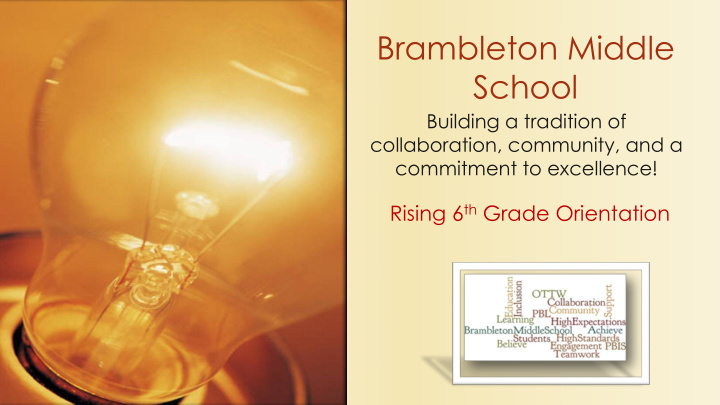



Brambleton Middle School Building a tradition of collaboration, community, and a commitment to excellence! Rising 6 th Grade Orientation
Agenda Items Welcome Introduction of Staff School Introduction Starting Point Goals Grading Scale Middle School Teaming Block Scheduling Building a Tradition of Excellence PBIS
Renée Dawson, Principal
16 th LCPS Middle School
Brambleton Middle School Sycolin Creek Legacy Creighton’s Corner Madison’s Trust Elementary Feeder Schools
Brambleton Middle School Stone Hill Middle School Eagle Ridge Middle School Mercer Middle School Middle School
Brambleton Middle School 6 th grade House Area Art Tech Ed Computer Labs Music Auditorium Main and Aux Gym Cafeteria Media Center Keyboarding FAC’s Main Office Counselor Office Dean Office
Brambleton Middle School 7 th grade House Area 8 th grade House Area Counselor Office Dean Office Teacher Work Rooms Multi-Purpose Room Connector Crosswalk
Grading Scale A= 90-100 98- 100 = A+ B = 80-89 90-92 = A- C= 70-79 87-89 = B+ 80-82 = B- D= 60-69 77-79 = C+ 70-72 = C- F= 0-59 66-69 = D+ 60-62 = D-
The Teaming Model 4 Core Teachers ◦ Math ◦ Science ◦ Social Studies ◦ Language Arts 120 - 125 Students Per Team Teachers have common planning during students’ resource block
Purpose of Grade Level Teams To meet the needs of all students To serve as a professional growth group To establish common To build positive, expectations and collaborative relationships procedures To connect concepts and To speak as “one voice” skills across the curriculum with parents
BLOCK SCHEDULING
Block Scheduling 90 Minute Blocks Alternating A and B Days 4 Classes Per Day Language Arts Meets Daily
Block Scheduling More time to go in depth Provides for more creative instructional strategies Fewer transitions Balance of assignments, projects, and tests
SAMPLE BLOCK SCHEDULE Block 1 Block 5 Resource/Music Math Block 2 Block 6 Lang. Arts PE Block 3 Block 7 History S1 Art S2 Keyboarding Block 4 Block 8 Lang. Arts H Science
Block Schedule A B A B A 8:30-10:03 8:30-10:03 8:30-10:03 8:30-10:03 8:30-10:03 Chorus Health/PE Chorus Chorus Health/PE (Resource) (Resource) (Resource) 10:08-11:37 10:08-11:37 10:08-11:37 History 10:08-11:37 10:08-11:37 History Science Science Science Monday Tuesday Wednesday Friday Thursday 11:42-1:42 11:42-1:42 11:42-1:42 11:42-1:42 11:42-1:42 Language Arts Language Arts Language Arts Language Arts Language Arts (lunch) (lunch) (lunch) (lunch) (lunch) 1:47-3:18 1:47-3:18 1:47-3:18 1:47-3:18 1:47-3:18 Math Art/Keyboarding Math Math Art/Keyboarding
COURSE OVERVIEW ALL 6 TH GRADERS TAKE: Language Arts (Honors or Academic) History (Honors or Academic) Science (Honors or Academic) Math (Accelerated Math 6/7 or Math 6) PE/Health Art & Keyboarding Music (student choice)/Resource
Standard Social Studies Sequence 6 th Grade Topics 6 th Grade 7 th Grade Geography of the USA U.S. • U.S. and the World History History Until 1865 Native Americans • From 1865 Exploration, America, • West Africa • 8 th Grade Colonial America: • Trade and Slavery Civics and War for Independence: • Figures, Events, Issues Economics * Confederation Period • The US Constitution • US Expansion • Reform and Abolition • * SOL Test Civil War: • Figures, Events, Issues
6 th Grade Science Scientific Method Matter Water Atmosphere Space Energy Resources Watersheds
6 th Grade Language Arts *Demonstrate critical thinking skills *Develop a literary background *Read challenging literature independently *Develop grammar, usage, spelling and mechanics through the writing process *Implement skills in the use of electronic technology *Develop oral communication skills * SOL Test – 6 th Grade Reading
Honors v. Academic Honors classes apply Academic classes work deep content toward mastery learning knowledge to of concepts and their observations and applications. synthesizes ideas based on learning.
Math Progression for 2017-2018 Algebra I Mathematics 6 Mathematics 7 Mathematics 8
Math Progression for 2017-2018 Geometry Algebra I Accelerated/Mathematics 6/7 Math 8 Algebra I
COURSE OVERVIEW 6 TH GRADE OPTIONS: MUSIC Band Instrument Strings Chorus General Music Lab
INSTRUMENT NIGHTS J. L. L. SIMP MPSON SON February 13 th at 7:00 PM – Simpson Students (Sycolin Creek ) A-M February 15th at 7:00 PM – Simpson Students (Sycolin Creek ) N-Z STONE E HI HILL LL February 21 st at 6:00 PM – Stone Hill students EAGLE GLE RI RIDGE GE February at 6:00 PM – Eagle Ridge students
PROGRAM OF STUDIES HIGHLIGHTS Registering for classes – Pages 1 Special Programs – Page 6 ◦ Spectrum ◦ Academy of Science ◦ Thomas Jefferson High Math Progression Chart – Page 8 High School Credit Courses in Middle School – Page 4 Course Descriptions – Page 9-11
PBIS – What is it? Identify needs, develop strategies, and evaluate practice toward success. P BIS Common approach Consistent Behavior to discipline. Data- Expectations that driven to determine are clearly defined trends or areas of and monitored need Continuum of support to facilitate positive responses to address negative behavior
PBIS We learn through support and encouragement: Positive Relationships
What is the importance of the “12 th Man? The presence of fans can have a profound impact on how the teams perform, an element in the home advantage. Namely, the home team fans would like to see their team win the game.
Organizational Features Common Vision School Community Common Common Practices Language
INTERSECTION OF OUTCOME AND PRACTICE Effective/Innovative Student Behavior Teaching Management Achievement
Building a Tradition of Excellence Commitment Student Achievement Collaboration Community
Student Voice
Student Voice
References: Association for Middle Level Education: http://www.amle.org/BrowsebyTopic/WhatsNew/WNDet/TabId/270/ArtMID/888/ArticleID/455/Developmental- Characteristics-of-Young-Adolescents.aspx Kellough, R. D., & Kellough, N. G. (2008). Teaching young adolescents: Methods and resources for middle grades teaching (5th ed.). Upper Saddle River, NJ: Pearson Merrill Prentice Hall. Scales, P. C. (1991). A portrait of young adolescents in the 1990s: Implications for promoting healthy growth and development. Carrboro, NC: Center for Early Adolescence, School of Medicine, University of North Carolina at Chapel Hill. Scales, P. C. (2010). Characteristics of young adolescents. In This we believe: Keys to educating young adolescents (pp. 63-62). Westerville, OH: National Middle School Association. Neil Slevin
Recommend
More recommend